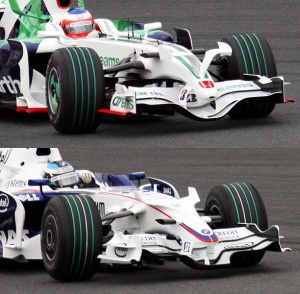Formula One tires
Formula One tyres play a significant role in the performance of a Formula One car. The tyres have undergone significant changes throughout the history of Formula One, with different manufacturers and specifications used in the sport.
Formula One tyres bear only a superficial resemblance to a normal road tyre. Whereas the latter has a useful life of up to 80,000 km, the tyres used in Formula One are built to last less than one race distance. This is determined by the compound of the rubber used. In 2005, tyre changes were disallowed in Formula One, the compound was harder as the tyres has to last the full race distance (around 300 km). Tyre changes were re-instated in 2006, following the dramatic and highly political 2005 United States Grand Prix (see below).
By regulation, the tyres feature a minimum of four grooves in them, with the intention of slowing the cars down (a slick tyre, with no indentations, is best in dry conditions). They can be no wider than 355 mm and 380 mm at the front and rear respectively and maximum diameter is 660 mm (670 mm for wet tyre). Slick tyres are to be reintroduced as of 2009.
For the 2007 season Bridgestone became the sole tyre supplier in Formula One with the withdrawal of Michelin, and introduced four compounds of tyre, two of which are made available at each race. The harder tyre is more durable but gives less grip, and the softer tyre gives more grip but is less durable. Both compounds have to be used by each car during a race and the softer tyre has a painted white stripe in the second groove to distinguish between compounds. This was introduced after the first race of the season when confusion occurred because a small dot was put on the sidewall of the tyre, instead of the white stripe. Each team must use each specification during the race, unless wet or intermediate tyres are used during the race, in which case this rule no longer applies.
In extremely wet weather, such as that seen in the 2007 European Grand Prix, the F1 cars are unable to keep up with the Safety Car in deep standing water due to the risk of aquaplaning.
2005 United States Grand Prix controversy
Main article 2005 United States Grand Prix

On Friday, 17 June 2005, during the afternoon's practice session, Ralf Schumacher driving for Toyota, crashed heavily in Turn 13 of the Indianapolis Motor Speedway road course, apparently as a result of a left-rear tyre failure. Turn 13 on the Indianapolis Motor Speedway road course is a high speed banked turn, unique to Formula One racing, that causes a greater than usual lateral (horizontal) load. This pressure can cause the side walls of the tyre to bow and wear in abnormal places.
The following day, Michelin reported that the tyres it had provided for its seven customer teams — BAR, McLaren, Red Bull, Renault, Toyota, Sauber, and Williams — were unsafe for extended high-speed use on this turn, and announced its intention to fly in another set of tyres from its Clermont-Ferrand headquarters. However, the replacement tyres flown in, which were of the type used in the Spanish Grand Prix earlier that year, turned out to have the same problem when tested.
In a letter to FIA Race Director Charlie Whiting Michelin representatives Pierre Dupasquier and Nick Shorrock revealed that they did not know the cause of Schumacher's tyre failure, and unless the cars could be slowed down in Turn 13, Michelin's tyres would be unsafe and unsuitable for use during the race. Whiting replied, expressing his surprise that Michelin had not brought along a second set of tyres, suggesting that the teams be informed of the maximum safe speed in Turn 13, and offered to monitor the turn by penalising any excess speed on the Michelin cars. He also addressed several solutions which had been proposed by the teams, insisting that use of the tyres flown in overnight would result in penalties, and the placement of a chicane in the turn was "out of the question" — the race would not be sanctioned by the FIA (making it a non-championship race) if the track layout was changed. He deemed the Michelin teams' proposals to be "grossly unfair" to the Bridgestone teams.[1] In a second letter Dupasquier and Shorrock announced that they would not permit their teams to race on Michelin's tyres. The race then took place with only the Bridgestone teams taking part.
Make Cars Green campaign

At the 2008 Japanese Grand Prix the tyres had the grooves painted green, as part of a promotion by the FIA to reduce the impact of motoring on the environment, called Make Cars Green. The softer of the two types of tyre still had the innermost groove painted white, as per normal. [2]
Manufacturers
Since the start of the 2007 Formula One season Bridgestone have been the sole manufacturer. Past manufacturers include:
Records
Ordered by number of races won. Current tyre manufacturers are shown in bold.
External links
- FIA tyre regulation summary
- FIA tyre regulations
- The Aerodynamic Development of the Formula One Car
- Bridgestone Teams, Single Tyre Formula And Sole Supplier
- The ATLAS Rough Guide: How to Set Up a Formula One Car (Part One)
- MSN Formula One: Tyres
- ↑ Cite error: Invalid
<ref>tag; no text was provided for refs namedletters - ↑ F1 tyres to promote 'green' push Retrieved 8 October 2008
- ↑ In depth tyre manufacturers history in F1 www.statsf1.com Retrieved 17 August 2007
- ↑ Goodyear was sole tyre supplier in F1 from 1987-1988 and 1992-1996.
- ↑ Bridgestone provided tyres in a limited capacity at the 1976 and 1977 Japanese Grand Prix, then for the full season from 1997 onwards
- ↑ Bridgestone was sole tyre supplier in F1 from 1999-2000 and in 2007-2008
- ↑ Firestone was sole tyre supplier at the Indianapolis 500 races from 1950-1960.

